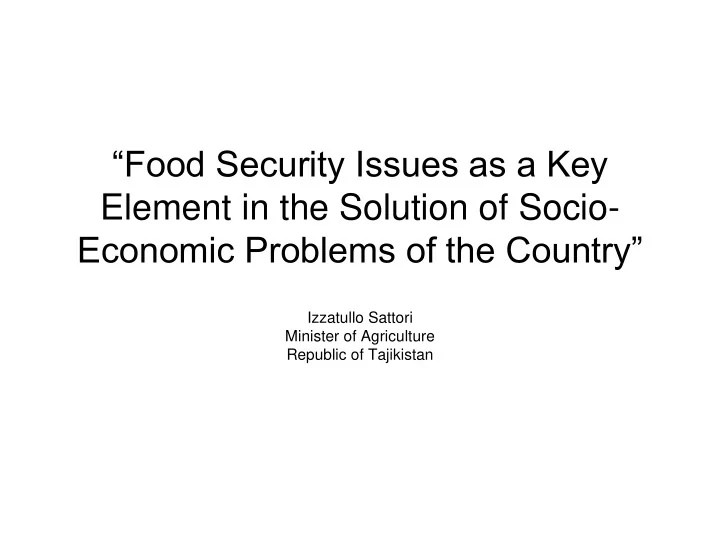

“Food Security Issues as a Key Element in the Solution of Socio- Economic Problems of the Country” Izzatullo Sattori Minister of Agriculture Republic of Tajikistan
Sector Context • Largest share of the population over 70% residing in the rural area, direct dependence upon agricultural sector • Key sector allowing massive rural income generation • Sector employing over 61 % of population • Competitive advantages due to agro-climatic conditions (early season, peculiar taste due to prevalence of sunny weather, non- excessive use of chemicals) • High potential of Tajik agricultural produce to take premium niche markets • Enhanced production of key food items to saturate the local market (cereal, starch, oil, protein)
Overview of agricultural production in Tajikistan (thousand tons) Comparative assessment for 2017 and Crop 2000 2005 2010 2017 2000 (+;-) % 550 935 1261 1447 897 1,6 times Cereals 303 555 760 783 480 2,6 times Potato 355 719 1143 1859 1504 4,2 times Vegetables 95 170 482 631 536 5,6 times Melons 170 148 225 405 176 2,4 times Fruit 110 91 124 228 118 2,0 times Grapes 59 108 143 249 190 4,2 times Meat 310 533 661 950 640 3,0 times Milk Eggs (million 24 99 232 341 317 14,2 times items) 3
General agricultural production per capita population in the Republic of Tajikistan during the period 1991-2017 (kg per capita) Crop 1991 1995 2000 2005 2010 2011 2012 2013 2014 2015 2016 2017 Cereal 54,3 42,2 89,8 133,8 165,7 142,8 154,1 172,5 159,6 165,8 164,2 165,6 Potato 32,3 18,9 49,5 80,2 100,9 113,3 123,9 138,2 103,4 105,0 102,7 89,5 112,1 83,3 57,9 103,8 151,7 163,1 167,8 184,6 187,6 197,2 200,0 212,6 Vegetabl es 31,2 19,7 15,6 24,6 64,1 55,6 58,1 61,3 66,1 70,1 67,9 72,2 Melons Fruit 31,6 25,2 27,7 21,4 29,9 34,1 39,2 40,7 41,3 35,4 41,6 46,3 Grapes 21,6 16,3 18,0 13,1 16,5 20,3 20,9 21,7 22,9 24,1 24,6 26,6 6,9 8,7 4,8 7,8 9,5 9,9 10,1 10,7 12,0 13,2 26,7 28,4 Meat 104,9 64,7 50,6 77,2 87,8 91,4 97,3 102,6 103,5 105,2 105,0 108,6 Milk 81,1 8,4 3,8 14,3 30,8 33,4 36,5 42,6 42,4 42,3 38,6 39,0 Eggs, items 4
Achievements • Successful land reform 1996- 2012 implementation. As a result 171’351 farms of various ownership forms established • Share of agriculture in GDP increased by 20% within the period 2000-2017 (24.5 bln. TJS = 270 MUSD) • Exploration of new lands, expanding the cultivated areas, including those under key food security crops. Over last 11 years 74’120 ha of new orchards and 8’504 ha vineyards were established • Tajik commodities are being exported to external markets: CIS, Europe, Asia, Middle East, America/Canada • Significant improvement of food processing, increase in number and quality of processing enterprises for the local market • Elaboration and implementation of corresponding sector policies and strategies: MtDS, Ag. Reform, Import Substitution • Commitment to institutional reform aimed at facilitating the development of the private sector in agriculture (FSC is established, priorities for the institutional reform of MoA are elaborated)
Challenges • Fragmented production and lack of knowledge of management farms, also lack online platforms for selling and buying inputs and agricultural products • Limited know-how and access to contemporary technologies • Underdeveloped access to finance • Slow development of logistics/transport infrastructure, weak consolidation and post harvest management • Insufficient introduction of production standards: Global Gap, Bio, Fair Trade affecting marketability of Tajik commodities • Insufficient coordination and collaboration between the stakeholders
Priorities/Food Security 1. Increase agriculture production 2. Reduce import of food supplies 3. Increase export volume of national production to regional markets 4. Increase agriculture sector contribution to GDP 5. Ensure more Tajikistan’s food processing companies are provided raw material from national production 6. Reclamation of additional 25,000 ha agriculture land
Priorities/Competitiveness 1. Enhance value addition in the country 2. Deploy implementation and certification of production in line with standards (Global GAP, Bio, etc) 3. Ensure consolidation of production to achieve economy of scale 4. Facilitate access to premium/niche markets 5. Attract investments for the development corresponding post harvest, logistic infrastructure 6. Promote Tajik brands on different fairs/exhibitions/platforms
Next Steps • Initiate introduction of production standards in the modality of 200 days of reforms • Strengthen the involvement of the private sector • Elaborate concise road maps for the implementation of the reform and track down implementation • Develop and introduce the FSM system with accordance of the international standards and regular monitoring of the food security situation;
Consolidation of efforts • Re-launch regular dialogue platform aimed at strengthening cooperation and communication • Finalize elaboration of the action plans as per identified priorities
Thank you for attention!
Recommend
More recommend